Weapons from the Bayesian canvas ...
Judith 14: 2
Rarities stories. Today we continue to study the tapestry from Bayeux, which, strictly speaking, is still not a tapestry, but an embroidery, but today we will deal not so much with the "tapestry" itself (there we have to consider perhaps the most interesting scenes!), As depicted on him with the weapons and equipment of the warriors.
First of all, it is interesting that both Harold's warriors and William's warriors are very similar in embroidery. Actually, you cannot distinguish them, if you do not know that the army of the first fought on foot, and the soldiers of the second - on horseback.
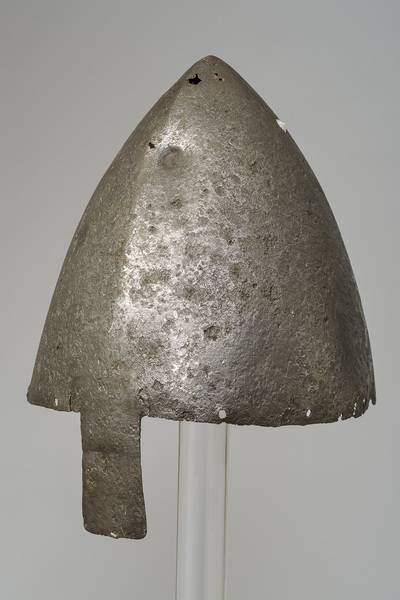
Typical one-piece forged helmet from the Battle of Hastings era. Found in Olomuts in 1864. Chamber of the court hunting and protective weapons. New Hovburg, Vienna
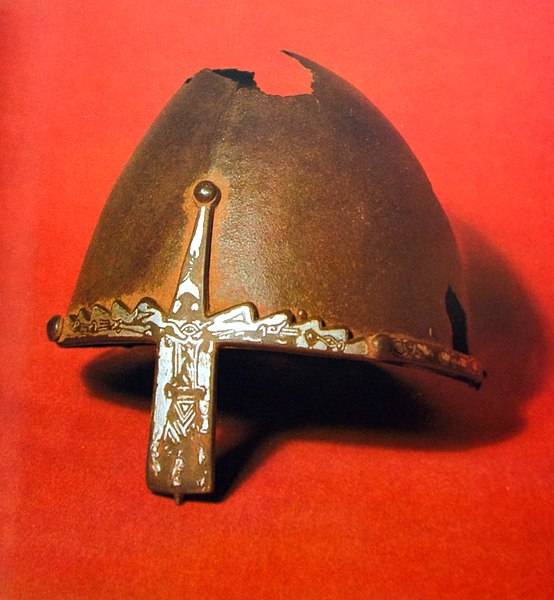
Norman helmet of St. Wenceslas 955. Chapel of the Holy Cross at Prague Castle
Judging by the images of the tapestry, both the nobility and ordinary warriors had a simple conical helmet as protection for the head, which could be either one-piece forged or riveted from several metal strips. A feature of all helmets was a fairly wide nose plate. The plate was wide enough to cover the face, together with chain mail, beyond recognition. It is obvious that the warriors did not wear liners made of fabric at that time. Most likely, the leather (or fabric) lining was inside the helmets themselves. According to the drawings on the tapestry, the helmets were painted on top to protect them from corrosion. Solid forged in one color, but riveted from stripes in different colors, so the warriors in them looked rather unusual in our modern opinion.
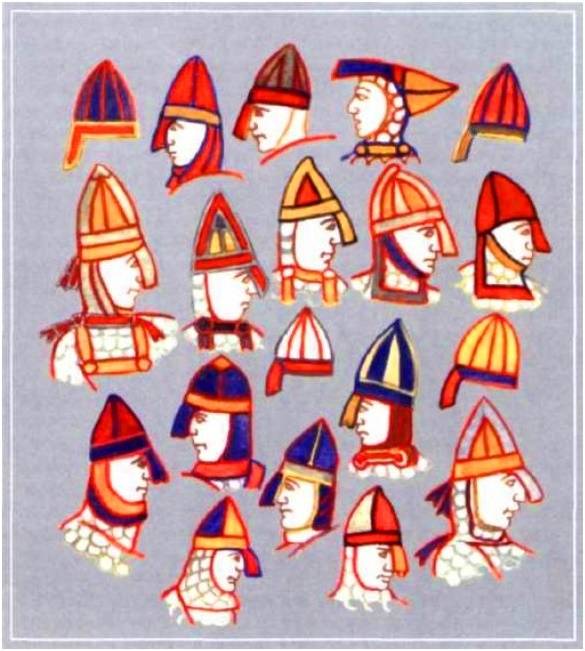
Painted Bayeux Tapestry helmets. Rice. I. Dzysya. "Zeikhgauz" No. 11 (6/2000)
Next comes chain mail. In the children's encyclopedia from 1968, on a page with images of warriors from different eras, a warrior from the Bayonne Carpet was also depicted, dressed in an overalls trimmed with rings - just like the armor of warriors on a tapestry. For a long time, I assumed that was the case. But then he looked at the border, where the chain mail from the fallen is being removed over the head and thought: "But what about short pants?" And then there was the sword, passed under the chain mail. If this is a shirt, then, in general, you can walk with it like that. But you can't walk with a sword tucked into your pants.
Then, in the books of the Osprey publishing house, I read that, apparently, what many used to take for chain mail overalls was actually chain mail, and the "pants" were its genders. It's just that the embroiderers did not bother to embroider the back of it, which, in theory, should have been visible between the legs. That is, a number of conventions in the images of the "carpet" still took place.
Again, judging by the images on the border, under the chain mail, William's horsemen and Harold's infantrymen had only one long shirt, like a night shirt. We see the same thing in the miniature from "The Bible of Matsievsky", which shows how the chain mail is taken off and put on, although there are also many images showing that something else was worn under it.
In general, the chain mail armor depicted on the "canvas from Bayeux" could well have been the most ordinary long-sex chain mail (clothes for the rider!) On ... lining and with slits in the front and back, like the later English coat. The floors of such chain mail, when walking, could well wrap around the legs and create the appearance of pants! By the way, it was in these chain mails with two cuts in front and behind the Normans that Angus McBride, an artist of the Osprey publishing house, painted. True, not a single such chain mail has survived to our time, but taking into account all the circumstances and again the images on the embroidery, it should have been that way.
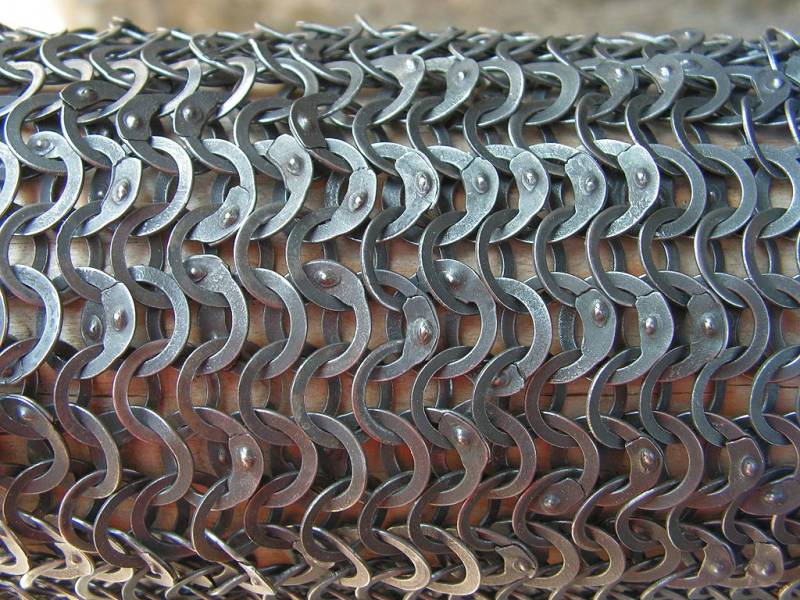
An example of the classic combination of rings, where four rings are connected in one - this is the technology that was used in the chain mail of St. Wenceslas
Chain mail of the XI century practically did not reach us, except in scraps. Moreover, among the relics of the Czech Republic there is the chain mail of St. Wenceslas weighing 10 kg, riveted from iron and gold rings.
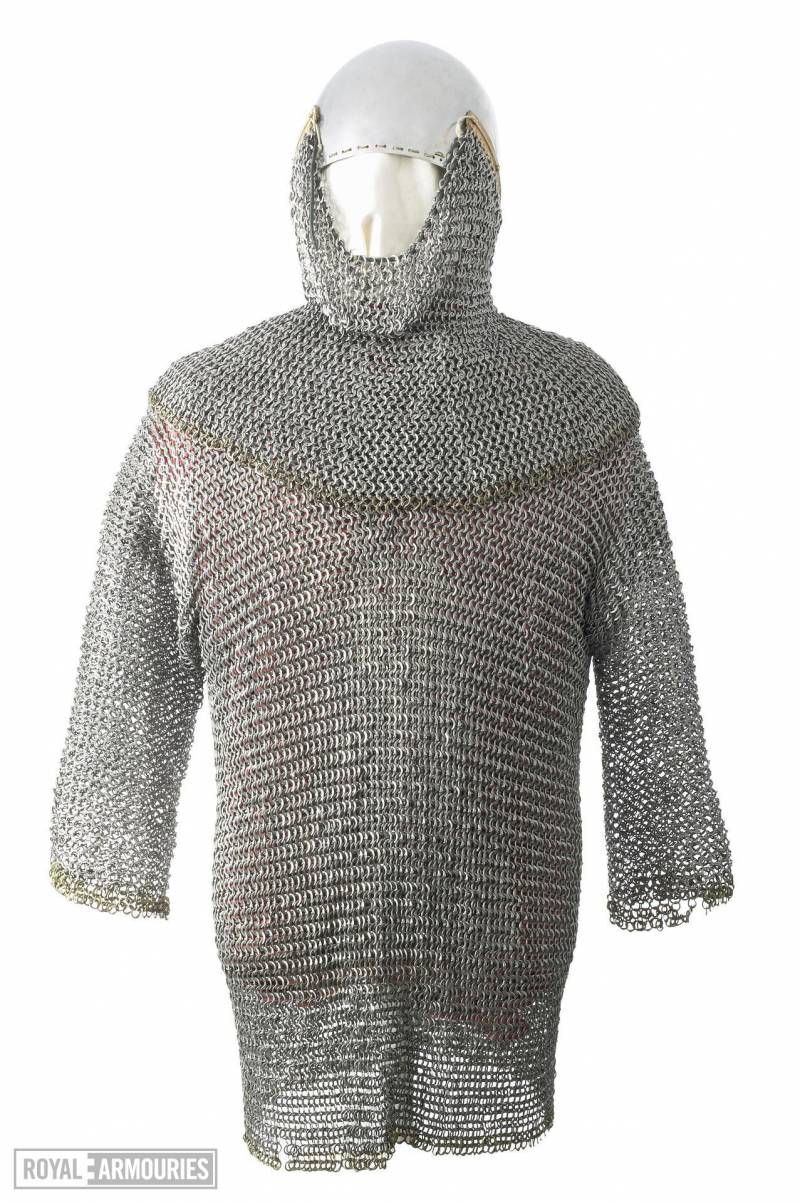
But in the Museum "Collection of Wallace" In London there is, for example, chain mail 1331-1370 years. It is believed to have belonged to Rudolf IV of Habsburg, Duke of Austria, Carinthia and Ferreta (1339-1365). The chain mail is hip-length with fairly wide three-quarter sleeves and consists of alternating rows of riveted and welded rings. The riveted links are closed by wedge-shaped rivets with small rounded heads with a diameter of 1,47 mm. The cuffs are edged with three rows of brass links held together with wedge-shaped iron rivets, and the bottom edge is framed in two rows. A collar made of thick riveted chain mail of the 12,68th century is added to the neck. Overall dimensions: rivet ring diameter outside 8,66 mm, inside 1,36 mm, wire thickness 2,00 mm, wire width 12,62 mm; diameter of the welded ring outside 8,31 mm, inside 1,30 mm, wire thickness 2,18 mm, wire width 1100 mm. When installed, the total height is 500 mm, the width is 10,57 mm. Weight: XNUMX kg
On the tapestry, again, there are often certain squares on chain mail on the chest of knights. This is most likely a leather-lined chain mail flap that covers the throat and lower face. It is easy to see that at the moment of the battle, instead of squares, only a narrow strip is depicted, and the lower part of the warrior's face is completely covered with chain mail.
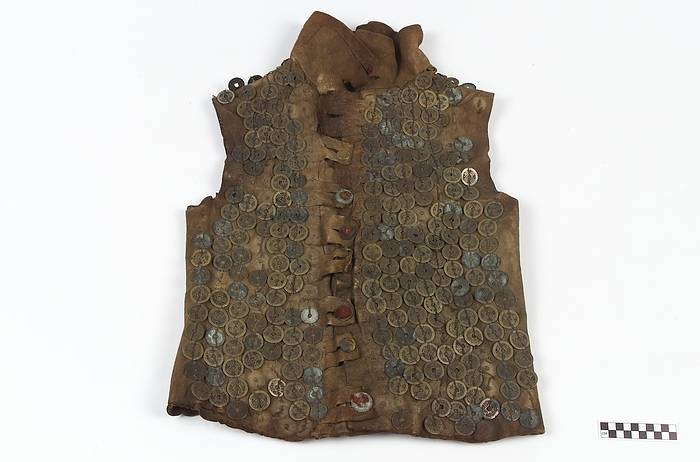
It is interesting that such armor jackets were worn by the Tlingit Indians. Smithsonian Institution National Museum of the American Indian, Washington
At one time it was believed that the Normans of Wilhelm used chain mail not from riveted, but from rings sewn onto fabric. The fact is that in miniatures from manuscripts of an earlier time, the armor of the riders is depicted as scaly. That is, it is armor made of metal plates sewn onto a soft base. And if so, why shouldn't the soldiers wear "armor" made of rings sewn onto the fabric? It seems to be logical ... But the fact is that it makes no sense to make such rings riveted. It is simpler - whole cut or shackled, but archaeologists do not find such, but scraps of classic chain mail are found.
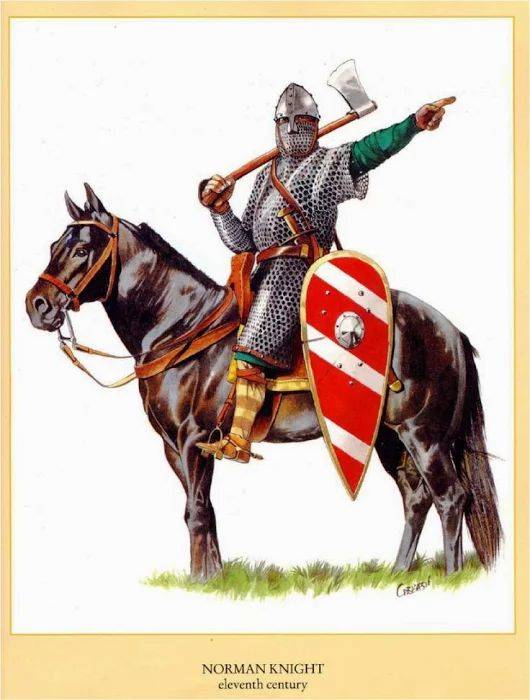
Drawings of some illustrators on the theme of such armor cannot but amaze. For example, an illustration from the book V. Vuksic, Z. Grbasic. "Cavalry. The history of fighting elite 650BC – AD1914 ”London, Cassell, 1994, depicting a Norman horseman in 1066. Well, why did they draw him like that? Firstly, there is no image of such a shield on the tapestry, and secondly, by the time the book was published, all disputes regarding the "pseudo-rings" on it seemed to have already subsided. And thirdly, why is the rider given an ax in his hand, moreover, of such a strange shape? They chopped firewood like that, not people. It is enough to look at the tapestry to be convinced of this! Or, say - first look at the tapestry and then look at the collections of the Royal Armory in Leeds. Was there not yet the Internet in 1991?
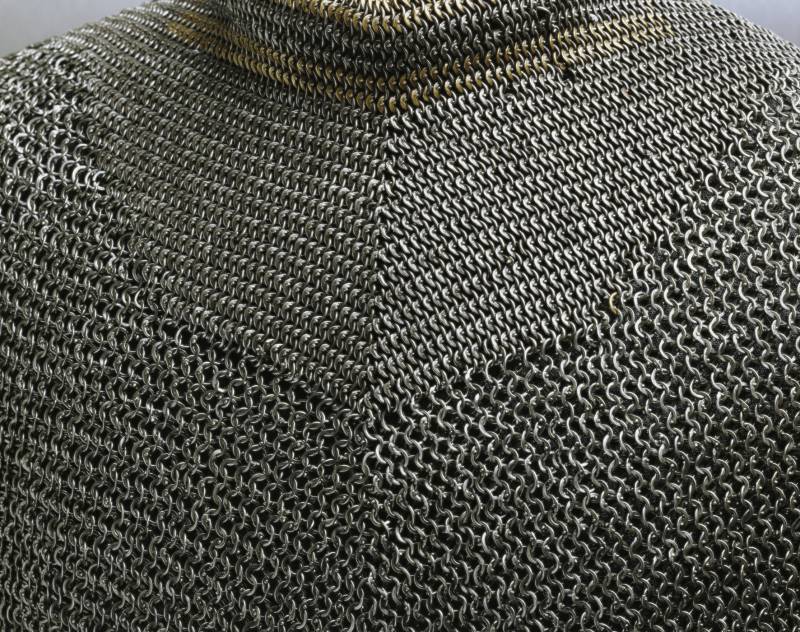
An example of chain mail weaving of the XNUMXth century. Chamber of court hunting and protective weapons. New Hofburg, Vienna
Some warriors on the canvas are depicted dressed, that is, they wear something similar to a long-length robe over their chain mail. Who is this? Bishop Odo is William's half-brother. Igor Dzys drew a remarkable reconstruction of his appearance in his time and published it in the Tseikhgauz magazine in 2000.
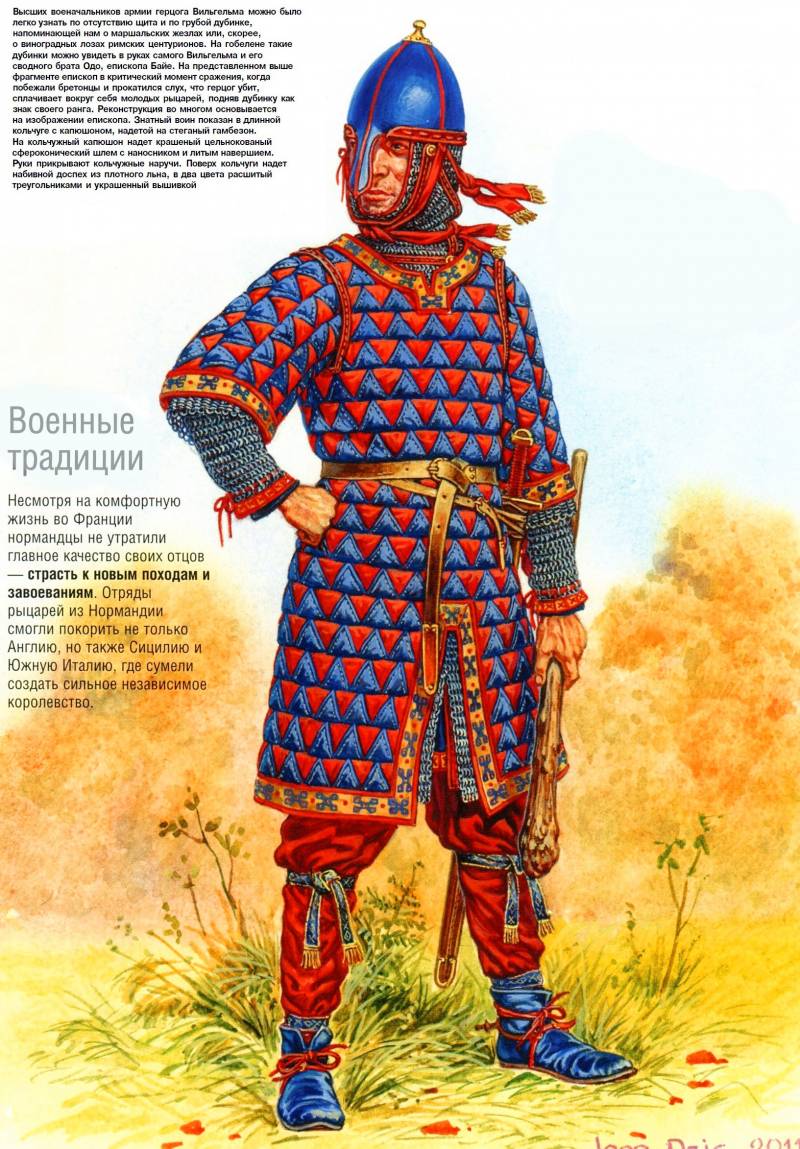
Here is his drawing. Article by I. Dzys and A. Shcherbakov "Army of Wilhelm the Conqueror". "Zeikhgauz" No. 11 (6/2000)
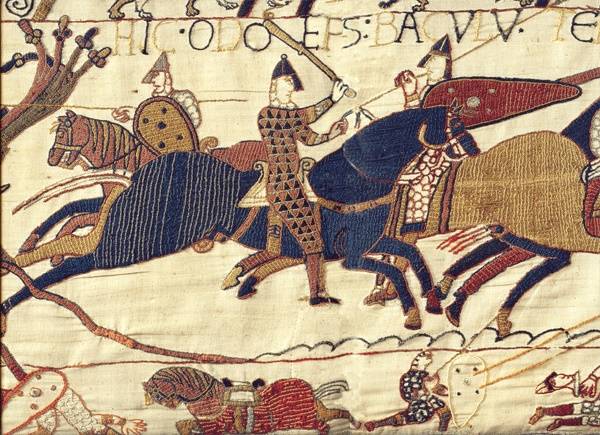
And this is how Bishop Odo is depicted on the tapestry. He is without a shield and in his hand he has a gnarled club - the wand of the leader. It is written that he encourages young warriors before battle!
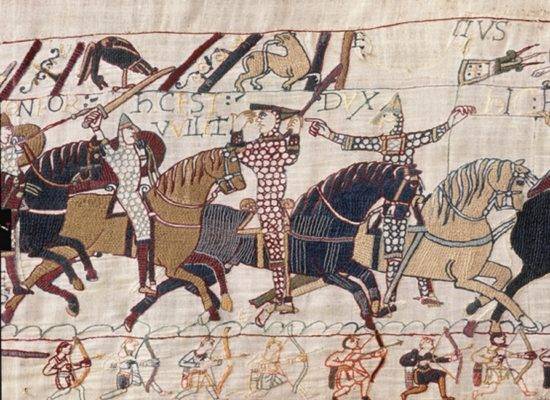
The famous tapestry scene depicting the moment when word spread among the Normans that their leader had been killed. "William is here!"- shouts Eustace of Bologna and forces Wilhelm to raise his helmet. It is significant that Eustace's chain mail has a square on his chest, but Wilhelm's does not. That is, it is obvious that this is some kind of removable piece of chain mail armor. Both the Conqueror and Eustace have chain mail stockings on their feet. Ordinary soldiers do not have them. That's just this on the tapestry to know and ordinary riders and differ
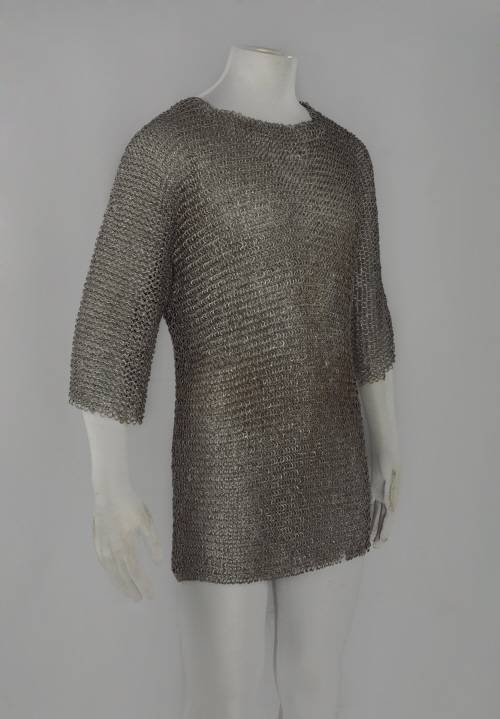
And this, for comparison, is chain mail from Augsburg, Germany, dating from the end of the XIV - the beginning of the XV century. Length: 73,7 cm. Diameter of rings: 1,11 cm. Weight: 4,479 kg
It is known that knights of the Early Middle Ages could wear two chain mail at once. The first was lined with silk or linen, the second was lined with leather, and on top of this two-layer armor was also covered with a quilted caftan. And this protection was so strong and perfect that it protected both from arrows and from stabbing blows with a sword. A chopping blow could shatter bones, but it was not able to cut through two layers of metal with a shock-absorbing pad. In particular, it was precisely such armor that the Arab knight Osama ibn Munkyz wore, as he wrote about in his Book of Edification.
We see two types of shields on the tapestry: round, convex among the Saxons, although they use both Norman shields, and teardrop-shaped, in the form of an "inverted drop" or "kite" (in English terminology). The shields have a metal umbo and are decorated with images of a branchy and expanding cross at the ends (the last image is only one), as well as the figure of a dragon. They not only protect themselves with shields, but also eat from them, using instead of tabletops! Many shields have no decorations at all.
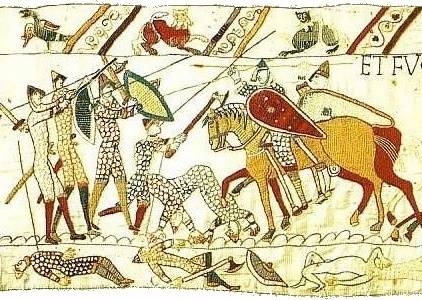
For example, here's how the shields of those fighting on fragment 58 look like ...
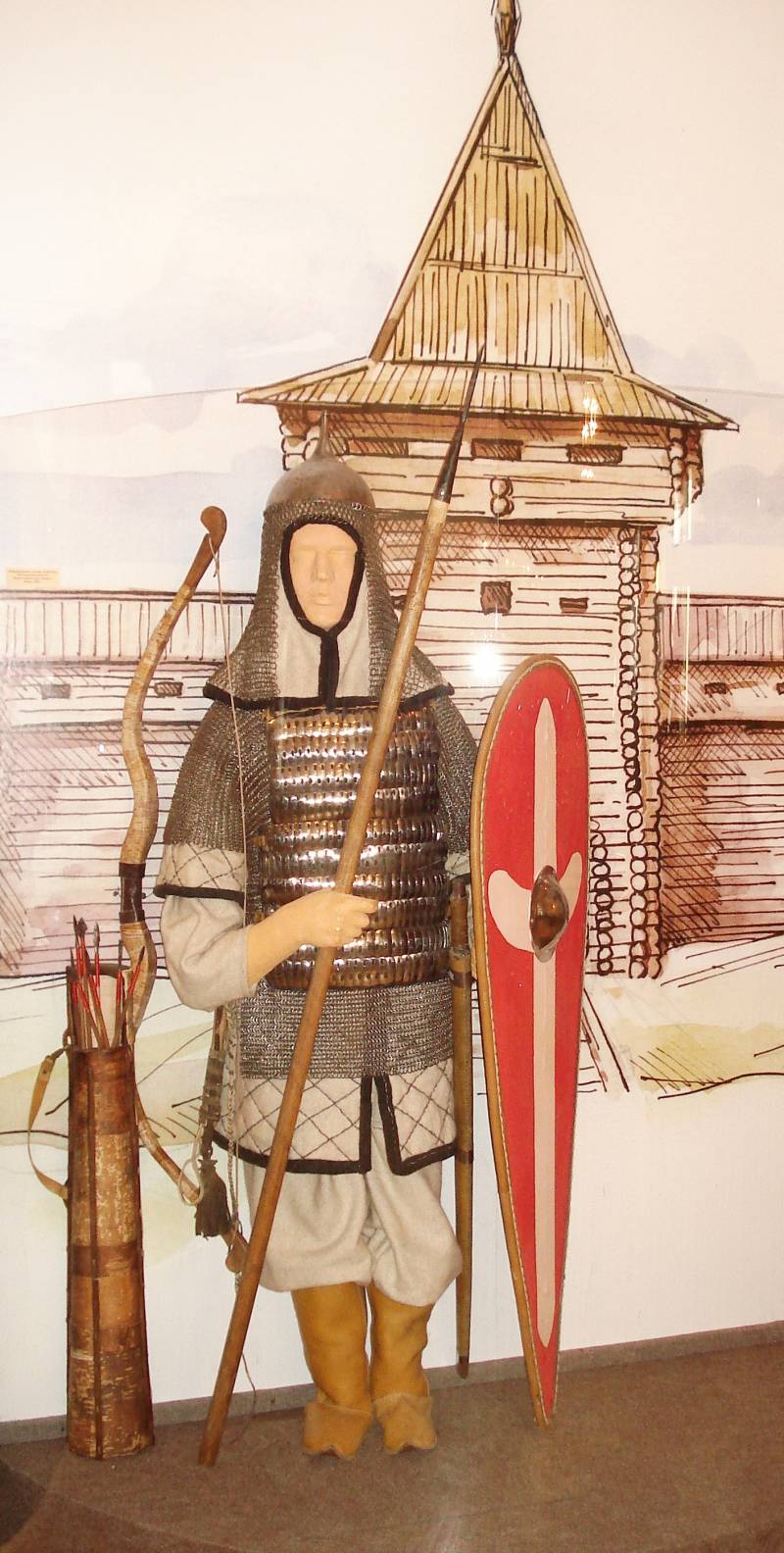
The cross, including those with sinuous ends, is a very ancient symbol. It is believed that such crosses also adorned the teardrop-shaped shields of Russian soldiers who defended the Zolotarevskoe settlement in 1236/37. This reconstruction was created based on the image of a warrior on one of the decorations, so this is not an invention - it was so. But, alas, it is impossible to verify what this meant. Museum of the Zolotarevskoe settlement. Pos. Zolotarevka, Penza region
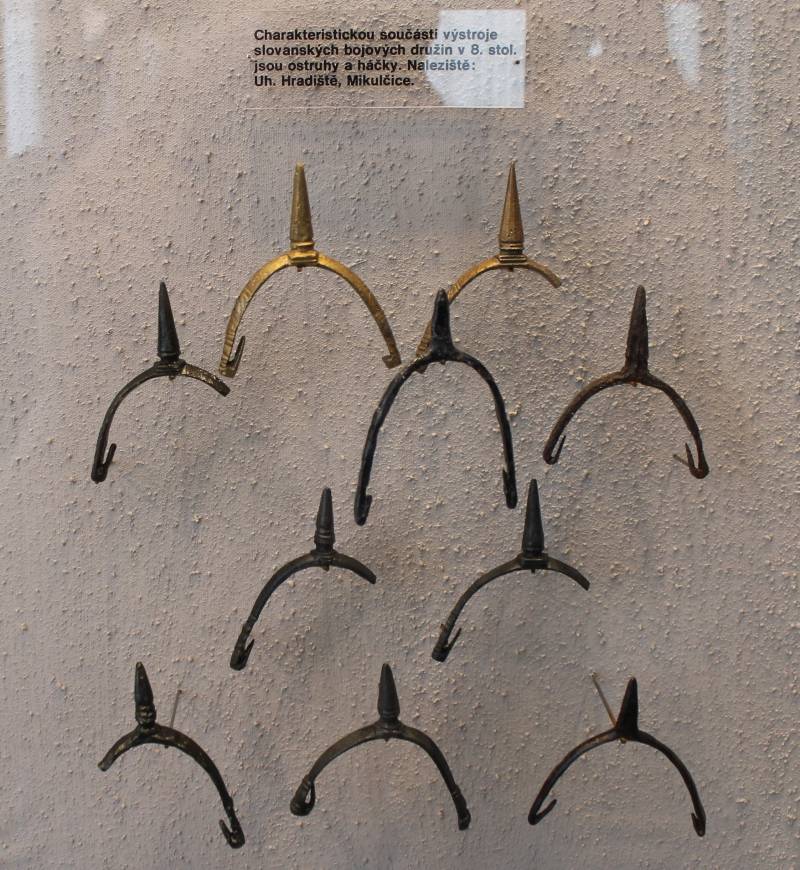
Spurs. Without them, a knight was not a knight, but at first they were very simple. Here's how these, for example, from the Moravian Museum in Brno. Photo by the author
The horsemen from the tapestry, for the most part, hold spears in a completely unqualified manner! That is, it is practically a technique of kushin a spear, when it is clamped under the armpit, they do not use it, but prefer to throw it. However, why so, it is understandable, because they have to fight with a wall of shields! Interestingly, the spearheads on the tapestry do not yet have a bounding crosshair. And, by the way, they are very similar to spearheads of that time, ubiquitous in Europe, including on the lands of Russia.
The shape of the tips was very different ...
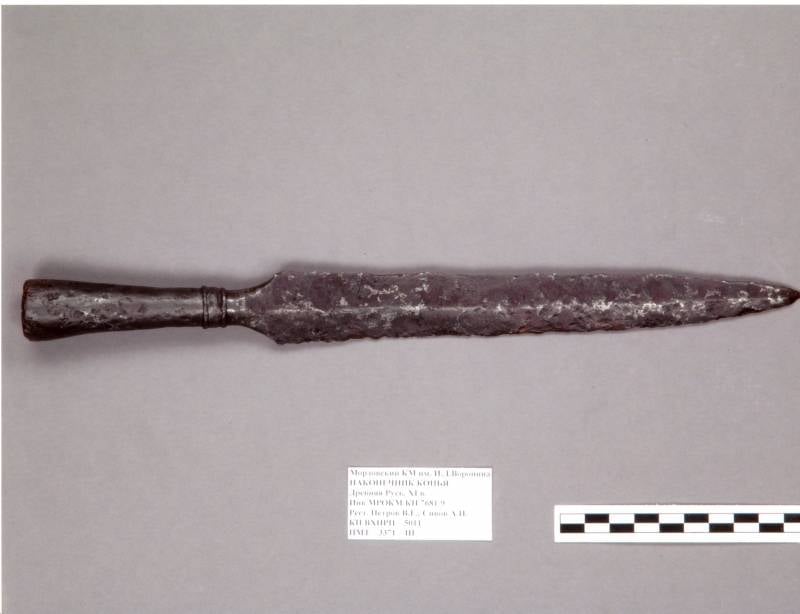
Another tip of the same time ... Mordovian Republican United Museum of Local Lore named after I. D. Voronin
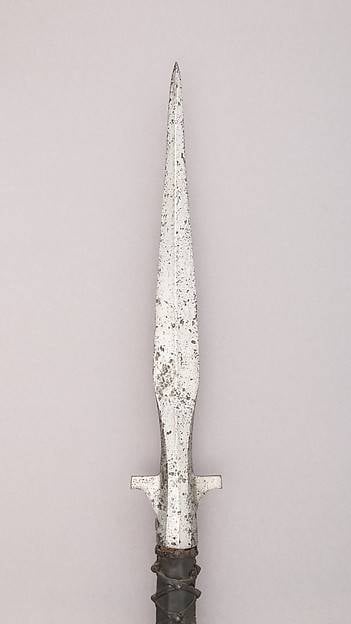
In theory, the riders' spearheads should have been like this, but ... in 1066 they had not thought of such a simple device as the “wings” on the tip sleeve. Spearhead 23,3th century Length 2579,8 cm.Weight XNUMX g. Metropolitan Museum of Art, New York
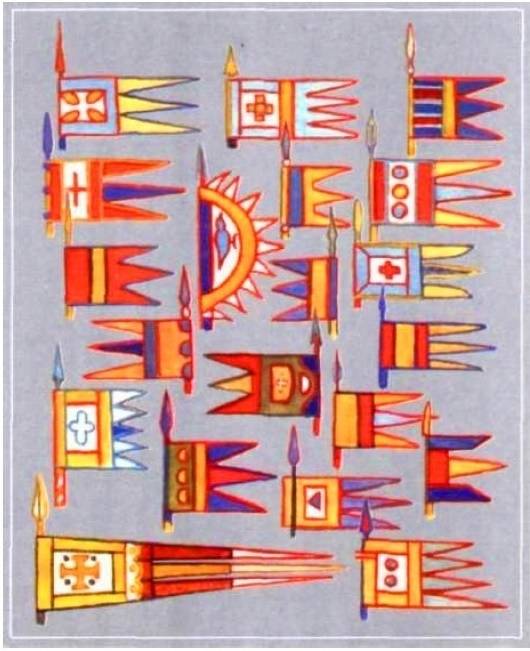
But the spears of many warriors on the tapestry were decorated with pennants and flags. Rice. I. Dzysya. "Zeikhgauz" No. 11 (6/2000)
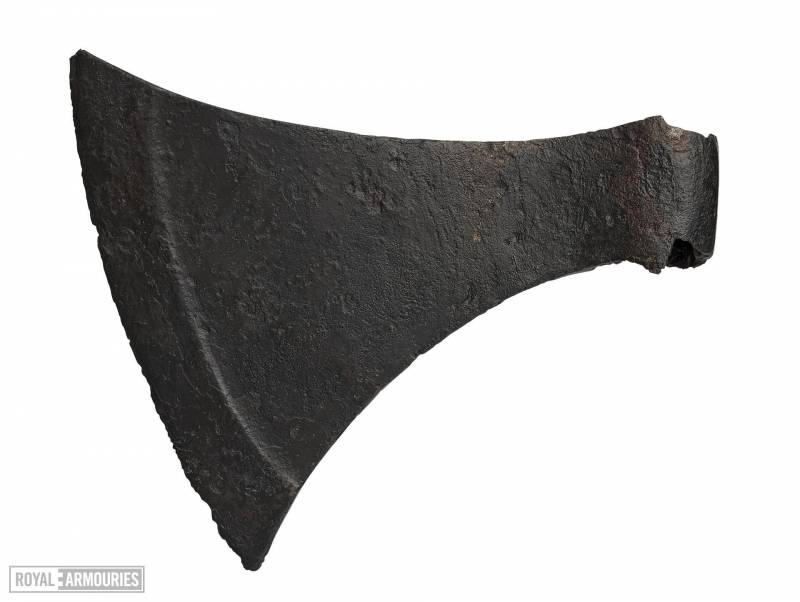
And here is finally the Norman battle ax, 900-1000. Royal Arsenal, Leeds. It was with such long-handled axes that the famous Huskerls fought!
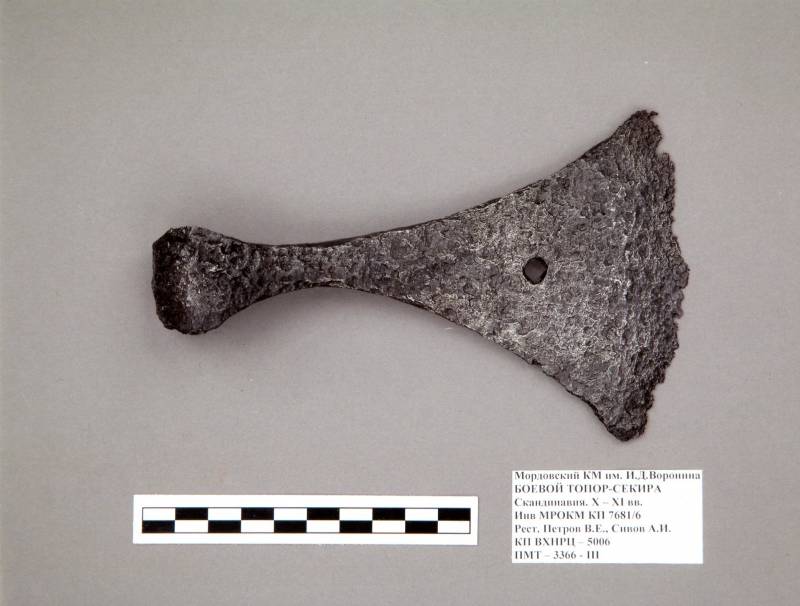
Battle ax-ax of the X-XI centuries, found on the territory of modern Mordovia. Looks like it, doesn't it? Mordovian Republican United Museum of Local Lore named after I.D.Voronin
And, of course, having used up all the spears, William's warriors began to chop the Saxons with swords, and they, in turn, even having swords (which is clearly visible on the tapestry), preferred to act with their axes!
The swords are very well depicted on the tapestry, and they are all similar to, for example, the photo of the sword from the collection of the Royal Arsenal in Leeds.
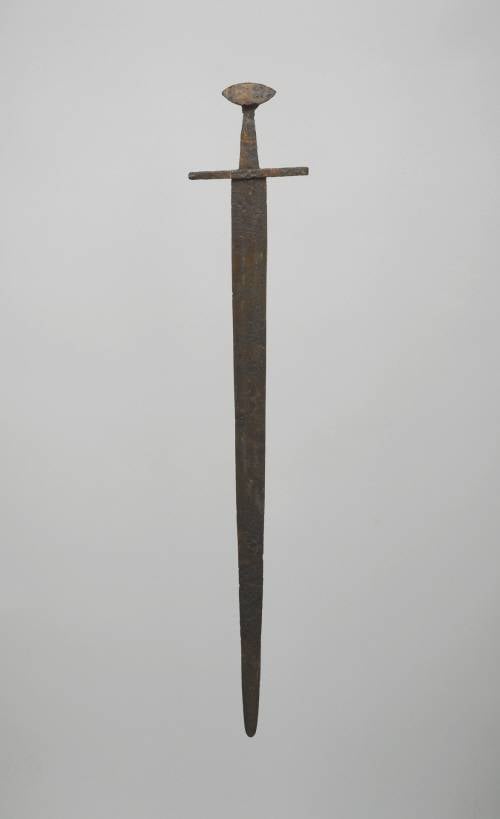
Sword, circa 980-1150 Germany. Material: iron and steel. Length: 82,2 cm; blade width: 5,1 cm. Weight: 1,195 kg. The top of the handle is in the form of a paranus (Brazilian nut), the crosshair is straight, square in section, slightly tapering towards the ends. The blade is double-edged, has a shallow lobe in the middle on both sides and tapers towards the point, now rounded and corroded. Royal Arsenal, Leeds
Archers played a very important role in the Battle of Hastings. They are depicted both on the main field and on the border. Moreover, there are images of archers, dressed, so to speak, in "ordinary clothes." But there are those who are shown dressed in chain mail and with a helmet on their heads.
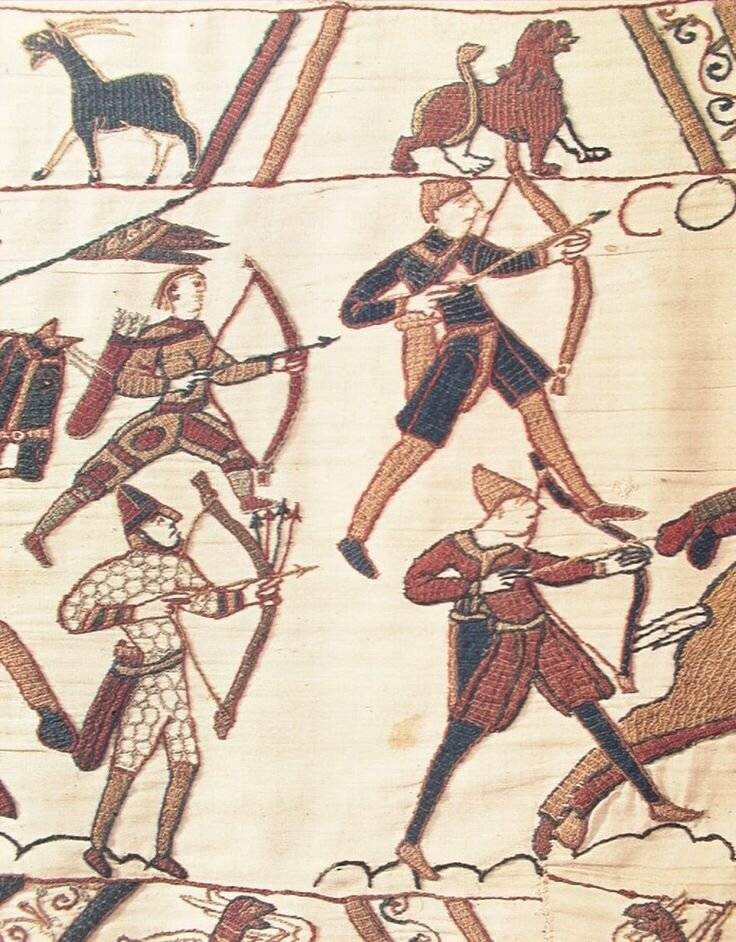
Four archers in the main field. "Embroidery from Bayeux"
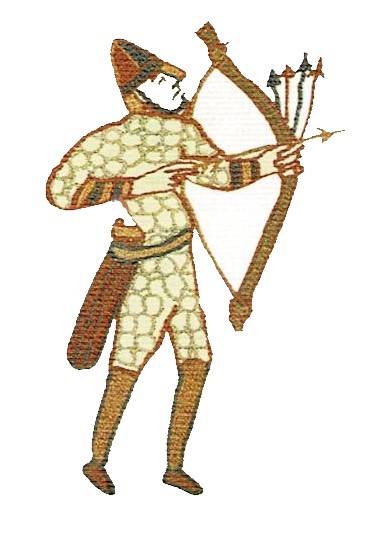
Archer in chain mail. It is interesting that he holds some of the arrows in his hand, that is, obviously for a higher rate of fire. Bows, however, are all relatively small in size. "Embroidery from Bayeux"
But there are much fewer archers on Harold's side on the embroidery (only one), and it is quite possible that this was precisely what played a role in his defeat ...
To be continued ...
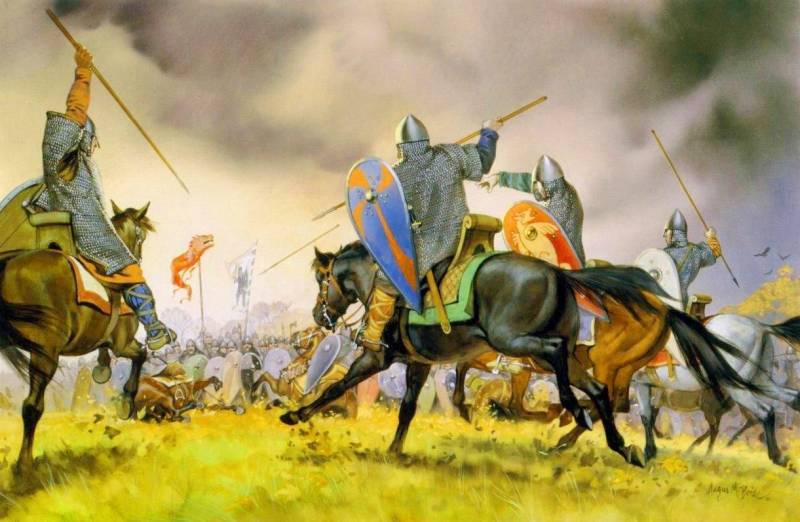
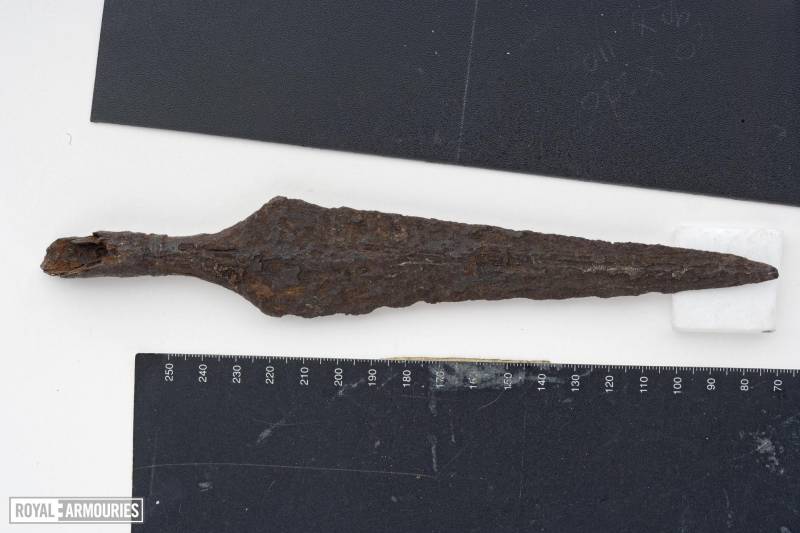

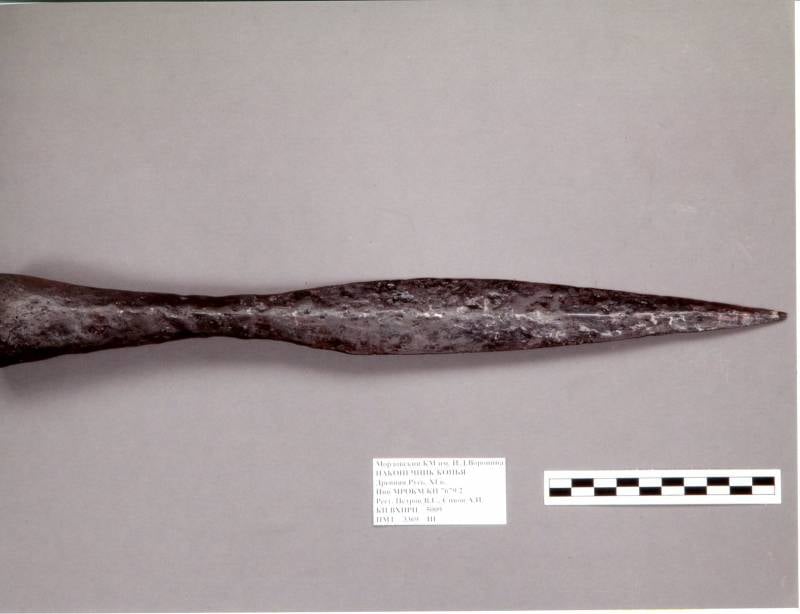
Information